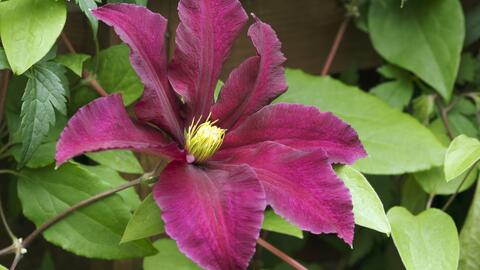10 Tips for Clematis
Clematis plants, some of which are also known as leather flower or vase vine, are climbers and voracious flowerers. They are, however, considered somewhat sensitive. And quite unfairly: with these tips, nothing will stand in the way of a year-round flower festival.

Large-flowered varieties in particular, such as the clematis hybrid “Niobe”, often fall foul to fungal wilt
Clematis are some of the most beautiful and beloved climbing plants in the garden. From planting to feeding to pruning: if you follow these 10 tips, your clematis will make itself right at home.
Large-bloomed clematis hybrids such as “Niobe” (photo) often suffer from clematis wilt. This fungal disease kills off all of the plant above ground. Aside from choosing the right location and good soil preparation, the only preventative measure is checking the plant regularly, especially in the summer months. Prune infected plants right down close to the ground immediately – they generally regrow when planted deeply enough (see tip 2).

Deep, humus-rich soil is important, and it should be evenly moist but not wet. You should therefore work in a generous amount of mature leaf compost and potting soil . If your soil is impermeable and loamy, a layer of builder’s sand at the bottom of the planting hole protects the roots from waterlogging. Voracious bloomers, clematis should be planted deep enough so that the first pair of buds are under the ground. This increases the chance that the plants will start to regrow shoots after a wilt infection.
In nature, wild clematis species generally grow in sunny patches at the edges of woodland or in clearings. Garden varieties have changed the size and color of their flowers but their location preferences have remained the same: they also prefer semi-shade with morning and/or evening sun as well as cool, shaded roots. Tip: Plant a couple of ferns or large-leafed herbaceous woodland perennials such as hostas or Rodgersia around your clematis.

All climbing clematis species use leaf stems to climb – their extended stems wrap around the climbing support to secure the thin shoots. Therefore, the ideal clematis climbing support is made up of preferably thin, predominantly upright rods or battens.
When it comes to , this climber generally copes well with a low level of nutrients. In nature, they rely on whatever is released by microorganisms in fall leaves and other decomposing plant matter. It is therefore completely sufficient to simply provide your clematis with two to three liters of mature compost in spring. Most wild species have a slightly higher lime requirement: simply sprinkle a handful of garden lime or algae lime around the roots every second winter.

Climbing roses and clematis are a match made in heaven for your garden. To make sure they develop well right from the start, a little know-how is required: Plant your rose two to three years before you add the clematis if possible, and separate the rooting space of the plants in the middle with a root blocker, such as a thin wooden board.
As do many woodland plants, clematis has a fine, shallow network of roots. Therefore, you should refrain from any interference in the soil around the plants’ rooting space. Pluck any weeds out by hand regularly: a mulch layer of pine bark is a helpful preventative measure. You should also avoid damage to the thin shoots, as this increases the risk of wilt infection (see tip 1).

Wild species and their selections, such as Mongolian clematis (Clematis tangutica), are generally stronger growers and less vulnerable to disease than highly cultivated large-flowered hybrids. But you don’t have to do without impressive flowers – Italian leather flower (Clematis viticella), for example, now has plenty of colorful garden varieties. They bloom voraciously and their flowers are only slightly smaller than those of clematis hybrids, depending on the variety.
If your clematis only flowers sparsely, this is often caused by a lack of light, e.g. if the plant is shaded by a tree. If the flowers remain small, a lack of water is usually the cause. A green shimmer on the flowers, known as clematis green petal, is a symptom of potassium deficiency but can also appear in low temperatures. However, this is a defining characteristic of some viticella varieties.
Italian leather flower varieties and all other varieties that only flower in summer should be pruned right down to the ground in spring (left). Clematis hybrids that bloom twice are gently pruned in spring so that the first lot of flowers in late spring or early summer isn’t too meager (right)
When pruning clematis, you should split clematis varieties up into three pruning groups depending on their flowering periods. Varieties that only bloom in summer, such as viticella varieties, should be cut back to around 12 inches in spring. Wild varieties that flower in spring do not generally need pruning. Some large-flowered hybrids bloom in spring on old wood and in summer on new wood. A gentle prune in spring encourages the first lot of flowers, while drastic pruning benefits the second flowering in summer.


